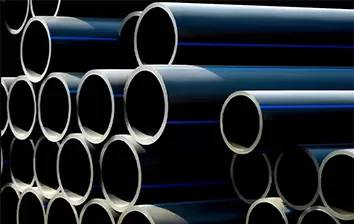Many countries' municipal pipe market utilizes polyethylene (PE) for water supply and gas pipes due to its high strength, temperature resistance, and corrosion resistance. PE is a suitable alternative to traditional iron pipes since it doesn't rust. China's National Bureau of Standards revised the GB/T 13663-2000 standard, which now specifies different levels of water supply pipes, like PE80, based on pressure strengths. The new standard removed tensile strength properties and introduced a requirement for elongation at break to exceed 350%, highlighting the material's toughness.
Of all engineering plastics, High-Density Polyethylene (HDPE) is noted for its abrasion resistance, which is the highest of any plastic. The higher the molecular weight the more wear-resistant the material is, even exceeding many metallic materials (e.g. carbon steel, stainless steel, bronze, etc.). Under strong corrosion and high abrasion conditions, the service life of HDPE is 4-6 times that of steel pipe and 9 times that of ordinary polyethylene, and it can also improve the conveying efficiency by 20%. In addition, it has good flame retardant and anti-static properties, all of which meet the standard requirements. The service life of the underground is more than 20 years, with remarkable economic benefits, impact resistance, wear resistance and double resistance.
Sewage PE pipe is also known as high-density polyethylene pipe, English that is: HDPE. This kind of pipe is often used as municipal engineering pipe, mainly used in the sewage treatment industry. Because of its wear-resistant, acid corrosion resistance, high-temperature resistance, high-pressure resistance and other characteristics, gradually replaced steel pipe, cement pipe and other traditional pipes in the market, especially because of the light weight of this pipe, ease of installation and movement, is the choice of new materials. Users should also pay special attention to the following points when choosing pipes made of this material:
Pay attention to the choice of raw materials for plastic pipes. There are thousands of grades of polyethylene raw materials, and there are as low as a few thousand dollars a tonne of raw materials on the market, this raw material production of products must not be constructed, otherwise, it will cause huge rework losses.
When selecting a pipe manufacturer, it is essential to choose a formal and professional one.
When purchasing PE pipe, it is important to examine the manufacturer’s field to assess their production capacity.
JIANGTE PE pipes for water supply are a replacement for traditional steel and PVC pipes. They must withstand certain pressures, making HDPE resin the preferred choice due to its superior mechanical properties.
Low-Density Polyethylene (LDPE) resin is unsuitable for pressure pipes because it has low tensile strength and poor pressure resistance. However, HDPE is widely used for drinking water pipes due to its high health standards, low melt viscosity, and good fluidity, with a melt index typically ranging from 0.3 to 3 g/10 min.
